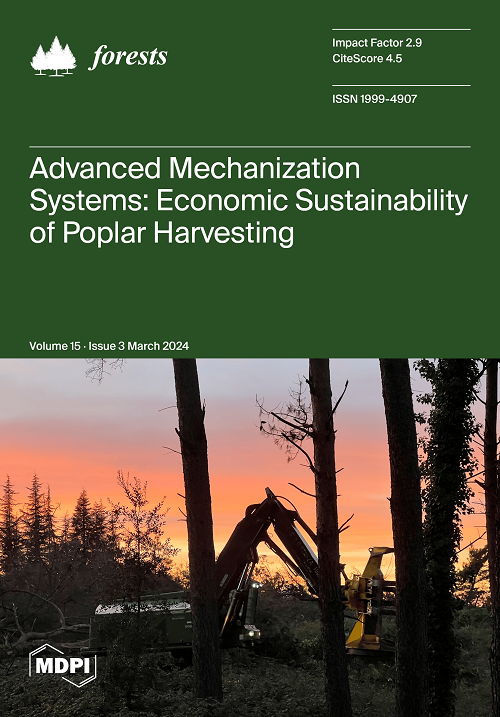Experimental Analysis on the Behaviors of a Laboratory Surface Fire Spreading across a Firebreak with Different Winds
IF 2.5
2区 农林科学
Q1 FORESTRY
引用次数: 0
Abstract
In this work, a series of laboratory surface fire experiments were performed over a pine needle fuel bed to investigate the effectiveness of a firebreak and the behaviors of a surface fire across a firebreak. Seven wind velocities of 0~3.0 m/s and six firebreak widths of 10~35 cm are varied. The behaviors of a surface fire across the firebreak, the heat flux received by fuel surface and fuel temperature before and after the firebreak are analyzed and compared simultaneously. The main conclusions are as follows: the behaviors of a surface fire spreading across a firebreak under different wind velocities are classified into three categories—no ignition, ignition by flame contact and ignition by spot fires. When the wind velocity is not more than 1.0 m/s, the surface fire cannot successfully cross the firebreak; as wind velocity changes from 1.5 m/s to 2.5 m/s, the fuel after the firebreak can be ignited by flame contact for relatively narrow firebreak conditions; when the wind velocity increases to 3.0 m/s, the burning fuel can be blown away along the fuel bed, and the fuel behind the firebreak will be ignited by spot fire. A linear relationship between the threshold of firebreak width and the fireline intensity is obtained, and the linear fitting coefficient in this paper is larger than the results reported by Wilson (0.36). For no ignition conditions, the fuel temperature and the heat flux received by the fuel after firebreak are significantly lower than those before the firebreak, whereas their variations over time are similar to those before the firebreak for ignition conditions. Moreover, for no ignition conditions, the maximum fuel temperature and the heat flux after the firebreak increase with wind velocity, but decrease with firebreak width. Additionally, when the fuel temperature (253 °C) and the heat flux received by the fuel considering the radiation and convection (43 kW/m2) after firebreak exceed a threshold value, the surface fire can successfully cross the firebreak.不同风力下实验室地表火在防火带蔓延行为的实验分析
这项工作在松针燃料层上进行了一系列实验室地表火实验,以研究防火带的有效性和地表火穿过防火带的行为。实验采用了 0~3.0 m/s 的七种风速和 10~35 cm 的六种防火带宽度。同时分析比较了地表火穿越防火带的行为、燃料表面接收的热通量以及防火带前后的燃料温度。主要结论如下:地表火在不同风速下穿过防火带的行为分为三类--无引燃、火焰接触引燃和点火引燃。当风速不大于 1.0 m/s 时,地表火无法成功穿越防火线;当风速从 1.5 m/s 变为 2.5 m/s 时,在防火线相对较窄的条件下,防火线后的燃料可以通过火焰接触点燃;当风速增加到 3.0 m/s 时,燃烧的燃料可以沿着燃料层被吹走,防火线后的燃料将被点燃。防火带宽度临界值与火线强度之间呈线性关系,本文的线性拟合系数大于 Wilson 报告的结果(0.36)。在无着火条件下,防火带后的燃料温度和燃料接收的热通量明显低于防火带前,而在有着火条件下,它们随时间的变化与防火带前相似。此外,在无着火条件下,防火带后燃料的最高温度和热通量随风速的增加而增加,但随防火带宽度的增加而减少。此外,当防火带后的燃料温度(253 °C)和燃料接收的辐射与对流热通量(43 kW/m2)超过临界值时,地表火可以成功穿越防火带。
本文章由计算机程序翻译,如有差异,请以英文原文为准。
求助全文
约1分钟内获得全文
求助全文
来源期刊

Forests
FORESTRY-
CiteScore
4.40
自引率
17.20%
发文量
1823
审稿时长
19.02 days
期刊介绍:
Forests (ISSN 1999-4907) is an international and cross-disciplinary scholarly journal of forestry and forest ecology. It publishes research papers, short communications and review papers. There is no restriction on the length of the papers. Our aim is to encourage scientists to publish their experimental and theoretical research in as much detail as possible. Full experimental and/or methodical details must be provided for research articles.
 求助内容:
求助内容: 应助结果提醒方式:
应助结果提醒方式:


